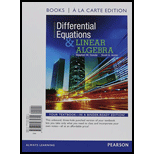
Differential Equations And Linear Algebra, Books A La Carte Edition (4th Edition)
4th Edition
ISBN: 9780321985811
Author: Stephen W. Goode, Scott A. Annin
Publisher: Pearson (edition 4)
expand_more
expand_more
format_list_bulleted
Textbook Question
Chapter A, Problem 22P
Problems
For problems 15-22, express the given complex-valued function in the form
Expert Solution & Answer
Want to see the full answer?
Check out a sample textbook solution
Students have asked these similar questions
A research study in the year 2009 found that there were 2760 coyotes
in a given region. The coyote population declined at a rate of 5.8%
each year.
How many fewer coyotes were there in 2024 than in 2015?
Explain in at least one sentence how you solved the problem. Show
your work. Round your answer to the nearest whole number.
Answer the following questions related to the following matrix
A =
3
³).
Explain the following terms
Chapter A Solutions
Differential Equations And Linear Algebra, Books A La Carte Edition (4th Edition)
Ch. A - Prob. 1PCh. A - Prob. 2PCh. A - Prob. 3PCh. A - Prob. 4PCh. A - Prob. 5PCh. A - Problems For Problems 6-10, express z1z2 and z1/z2...Ch. A - Prob. 7PCh. A - Prob. 8PCh. A - Prob. 9PCh. A - Prob. 10P
Ch. A - Problems Show that if z1 and z2 are complex...Ch. A - Problems Generalize the previous example to the...Ch. A - Problems Show that if z1 and z2 are complex...Ch. A - Prob. 14PCh. A - Problems For problems 15-22, express the given...Ch. A - Problems For problems 15-22, express the given...Ch. A - Problems For problems 15-22, express the given...Ch. A - Problems For problems 15-22, express the given...Ch. A - Problems For problems 15-22, express the given...Ch. A - Prob. 20PCh. A - Prob. 21PCh. A - Problems For problems 15-22, express the given...Ch. A - Prob. 23PCh. A - Problems Show that cosbx=12(eibx+eibx) and...Ch. A - Problems For Problems 2527, use the result of...Ch. A - Prob. 26PCh. A - Prob. 27PCh. A - Prob. 28P
Knowledge Booster
Learn more about
Need a deep-dive on the concept behind this application? Look no further. Learn more about this topic, algebra and related others by exploring similar questions and additional content below.Similar questions
- Solve questions by Course Name (Ordinary Differential Equations II 2)arrow_forwardplease Solve questions by Course Name( Ordinary Differential Equations II 2)arrow_forwardInThe Northern Lights are bright flashes of colored light between 50 and 200 miles above Earth. Suppose a flash occurs 150 miles above Earth. What is the measure of arc BD, the portion of Earth from which the flash is visible? (Earth’s radius is approximately 4000 miles.)arrow_forward
- e). n! (n - 1)!arrow_forwardSuppose you flip a fair two-sided coin four times and record the result. a). List the sample space of this experiment. That is, list all possible outcomes that could occur when flipping a fair two-sided coin four total times. Assume the two sides of the coin are Heads (H) and Tails (T).arrow_forwarde). n! (n - 1)!arrow_forward
- Evaluate the following expression and show your work to support your calculations. a). 6! b). 4! 3!0! 7! c). 5!2! d). 5!2! e). n! (n - 1)!arrow_forwardAmy and Samiha have a hat that contains two playing cards, one ace and one king. They are playing a game where they randomly pick a card out of the hat four times, with replacement. Amy thinks that the probability of getting exactly two aces in four picks is equal to the probability of not getting exactly two aces in four picks. Samiha disagrees. She thinks that the probability of not getting exactly two aces is greater. The sample space of possible outcomes is listed below. A represents an ace, and K represents a king. Who is correct?arrow_forwardConsider the exponential function f(x) = 12x. Complete the sentences about the key features of the graph. The domain is all real numbers. The range is y> 0. The equation of the asymptote is y = 0 The y-intercept is 1arrow_forward
arrow_back_ios
SEE MORE QUESTIONS
arrow_forward_ios
Recommended textbooks for you
 Intermediate AlgebraAlgebraISBN:9781285195728Author:Jerome E. Kaufmann, Karen L. SchwittersPublisher:Cengage Learning
Intermediate AlgebraAlgebraISBN:9781285195728Author:Jerome E. Kaufmann, Karen L. SchwittersPublisher:Cengage Learning College Algebra (MindTap Course List)AlgebraISBN:9781305652231Author:R. David Gustafson, Jeff HughesPublisher:Cengage Learning
College Algebra (MindTap Course List)AlgebraISBN:9781305652231Author:R. David Gustafson, Jeff HughesPublisher:Cengage Learning
 Algebra for College StudentsAlgebraISBN:9781285195780Author:Jerome E. Kaufmann, Karen L. SchwittersPublisher:Cengage Learning
Algebra for College StudentsAlgebraISBN:9781285195780Author:Jerome E. Kaufmann, Karen L. SchwittersPublisher:Cengage Learning Trigonometry (MindTap Course List)TrigonometryISBN:9781337278461Author:Ron LarsonPublisher:Cengage LearningAlgebra & Trigonometry with Analytic GeometryAlgebraISBN:9781133382119Author:SwokowskiPublisher:Cengage
Trigonometry (MindTap Course List)TrigonometryISBN:9781337278461Author:Ron LarsonPublisher:Cengage LearningAlgebra & Trigonometry with Analytic GeometryAlgebraISBN:9781133382119Author:SwokowskiPublisher:Cengage

Intermediate Algebra
Algebra
ISBN:9781285195728
Author:Jerome E. Kaufmann, Karen L. Schwitters
Publisher:Cengage Learning

College Algebra (MindTap Course List)
Algebra
ISBN:9781305652231
Author:R. David Gustafson, Jeff Hughes
Publisher:Cengage Learning


Algebra for College Students
Algebra
ISBN:9781285195780
Author:Jerome E. Kaufmann, Karen L. Schwitters
Publisher:Cengage Learning

Trigonometry (MindTap Course List)
Trigonometry
ISBN:9781337278461
Author:Ron Larson
Publisher:Cengage Learning

Algebra & Trigonometry with Analytic Geometry
Algebra
ISBN:9781133382119
Author:Swokowski
Publisher:Cengage
Interpreting Graphs of Quadratic Equations (GMAT/GRE/CAT/Bank PO/SSC CGL) | Don't Memorise; Author: Don't Memorise;https://www.youtube.com/watch?v=BHgewRcuoRM;License: Standard YouTube License, CC-BY
Solve a Trig Equation in Quadratic Form Using the Quadratic Formula (Cosine, 4 Solutions); Author: Mathispower4u;https://www.youtube.com/watch?v=N6jw_i74AVQ;License: Standard YouTube License, CC-BY